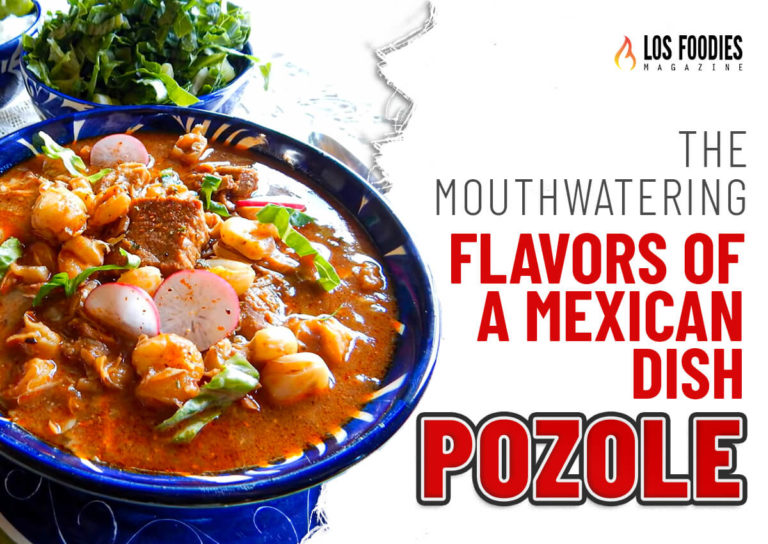Welcome to the delicious world of Pozole, a prized culinary gem bringing warmth to the heart and radiance to countless festive occasions in Mexico. This traditional Mexican soup, steeped in rich history, warms souls with its savory goodness and offers a taste buds tour through centuries of tradition. Join us as we venture into its savory depths.
A Brief History of Pozole
Originating in the sacred realms of pre-Columbian civilizations, Pozole was more than mere sustenance—it was a dish embedded in ritual and reverence, served primarily during special occasions. The Aztecs and their contemporaries revered Pozole, cooking it in a melting pot of indigenous customs and beliefs.
As time pirouetted forward, Pozole gently simmered into modern times, adapting and adopting new ingredients and culinary techniques, all while preserving its celebrated legacy.
Traditional Ingredients Used in Pozole
A quintessential Pozole bubbles with the rich, harmonious flavors of tender pork shoulder, robust hominy, and an entourage of aromatic ingredients such as garlic, oregano, and chili peppers. The secret—genuine passion for quality—encourages us to select ingredients at the peak of freshness for the most flavorful experience.
Here is a quick list of ingredients to make this authentic recipe:
- 1 1/2 lbs of pork shoulder
- Two garlic cloves peeled
- One tablespoon of cumin powder
- One chopped onion
- Two chopped garlic cloves
- Two tablespoons of oil
- 1/2 teaspoon of black pepper
- 1/2 teaspoon of cayenne pepper
- Two tablespoons of California chili powder
- One tablespoon of salt
- 1/4 teaspoon of oregano
- 4 cups of canned white hominy, drained and rinsed
- 3-5 cups of pork broth obtained by cooking pork shoulder
- 1 cup of canned diced green chilies (optional)
- Salt, to taste
- Two whole fresh jalapenos, chopped (optional)
- Three whole ancho chilies, seeded and stemmed (for garnish) (optional)
DIRECTIONS: Get the ingredients ready –
- Prepare and chop the veggies and measure out the spices.
- Soft boil the ancho chilies in a small pot separately for later use as a Garnish.
- Ready to cook: Cover the pork in a large pot with salted water.
- Add cumin, black pepper, half of the chopped onions, cloves of peeled garlic, and some oregano to the water with the meat.
- Boil and then simmer for 45 minutes; remove any foam.
- Save the cooked meat and the liquid after.
- Cook the rest of the garlic and onions in a pan with some oil until soft.
- Throw in the rest of your spices and cook them for another minute.
- Next, cut the pork into 1-inch cubes and add to your spices.
- Add the hominy, the pork liquid, extra chicken stock for more flavor, green chilies, and jalapenos if using them.
- Let everything simmer together for 45–60 minutes.
- Remove the grease from the top of the stew, fix the salt to taste, and put the stew in bowls to serve. It’s tasty!
GARNISHES YOU SHOULD USE:
- Lemon or lime wedges
- Sliced radishes
- Fresh cut cilantro
- Shredded green cabbage
- Tortilla chips or strips FOR THE ANCHO CHILI SAUCE:
- When the ancho chilies are soft, blend them with water, garlic, onion, and season with salt and pepper.
- Strain this mixture, keeping the liquid for adding to bowls as wanted. It’s very spicy.
- You can put the leftover pulp into the stew or throw it out.
The Importance of Hominy in Pozole
At the heart of Pozole lies hominy: corn kernels in transcendent form, each swollen with pride from their alkaline transformation. This cherished ingredient is not merely for sustenance; Pozole’s unspoken hero offers an irreplaceable depth and heartiness reminiscent of the land’s generosity and fertility.
Variations of Pozole Across Mexico
Pozole dresses in regional attire gleefully as we meander through Mexico’s rich tapestry. From Guerrero’s vibrant green Pozole, infused with pepitas and green chilis, to Jalisco’s pristine white Pozole, each region narrates its saga of taste and tradition. It’s the ultimate gastronomic mosaic of Mexico’s regional bites.
Here is some variation for you to try on –
- Pozole Blanco (White Pozole): Primarily found in states like Guerrero and Mexico City, this variation is simple and focuses on the essential ingredients such as hominy, meat (usually pork), and broth without any added red or green sauce. Common toppings include lettuce or cabbage, radishes, onion, oregano, and lime.
- Pozole Rojo (Red Pozole): Popular in states like Jalisco and Michoacán, red pozole includes a red sauce made from a variety of chilies like ancho, pasilla, or guajillo. The addition of this sauce gives the broth a distinctive red color and a slightly spicy flavor.
- Pozole Verde (Green Pozole): Mainly found in Guerrero and the central Pacific coast of Mexico, this version involves adding green tomatillos, jalapeños, or pumpkin seeds to the broth, resulting in its characteristic green color. Chicken is often the meat of choice for Pozole Verde, although pork can be used as well.
- Pozole de Mariscos (Seafood Pozole): A coastal variation, especially in states like Nayarit and Sinaloa. Instead of traditional meats, seafood pozole includes ingredients like shrimp, fish, squid, and sometimes scallops.
- Pozolillo: A variation made with green corn (elote) and smaller grains of hominy. This dish is more of a soup than a hearty stew, and it’s typically lighter with the inclusion of chicken.
Different regions often have their own unique twists on these varieties, or they may have special ingredients they prefer to add, marking the cultural diversity within Mexico through this traditional dish.
Different Types of Broth Used in Pozole
Pozole, a traditional Mexican soup, can be made with a variety of broths. Each type imparts its own unique flavor and characteristics to the dish. Here are a few types of broth that are commonly used in pozole:
- Chicken Broth: A light and commonly used base for many types of pozole, especially pozole blanco (white pozole). It brings out the flavors of the hominy and other ingredients without overpowering them.
- Pork Broth: Made by simmering pork bones, this rich and flavorful broth is often used in pozole rojo (red pozole) and provides a robust foundation that complements the red chile sauce typically incorporated in this version.
- Beef Broth: Less common but still delicious, beef broth provides a hearty taste and is occasionally utilized in preparations where a stronger meaty flavor is desired.
- Vegetable Broth: Ideal for vegan and vegetarian versions of pozole, this broth can be flavored with onions, garlic, celery, and cloves to provide a savory taste, suitable for accommodating the palate for those avoiding meat.
- Seafood Broth: For a coastal twist on pozole, a broth made from simmering fish or shellfish parts can be utilized, offering a lighter, yet still savory, seafood flavor.
- Combination Broth: Some cooks like to mix broths, such as chicken and pork, for a balanced flavor profile that incorporates the best aspects of multiple meat broths.
- Hominy Broth: In cases where a milder, corn-focused broth is preferred, the liquid from cooked hominy can also be used as a base for the soup, either alone or in combination with another type of broth.
When preparing pozole, it’s important that the broth complements the other elements, including the choice of pozole color (Blanco, Verde, rojo), the range of toppings (cabbage, radishes, avocado), and the type of protein (often pork or chicken). The broth should be flavorful enough to bring together the dish ⎼ but not overpower it.
Tips for Making Delicious Pozole at Home
Pozole is a traditional Mexican soup that usually features hominy, meat (often pork), and can be garnished with lettuce, chili peppers, onion, garlic, radishes, avocado, salsa or limes. To make a delicious pozole at home, consider the following tips:
- Start with Quality Ingredients: – Select a cut of pork with a good balance of meat and fat for rich flavor. Pork shoulder is a great choice. – Use fresh hominy. Canned hominy is a convenient alternative if dried hominy is not available.
- Properly Prepare Ingredients: – If you’re using dried hominy, soak it overnight to reduce cooking time. – Before cooking the meat, sear it to develop a deeper flavor.
- Invest Time in the Broth: – Allow the soup to simmer for several hours to enhance the flavors of the broth. – Regularly skim off any excess fat that rises to the top for a clearer broth.
- Balance Your Spices: – Toast your dried chilies before soaking them; this will bring out their flavors. – Grind the spices fresh if possible, as this makes a significant difference in flavor.
- Be Generous with Garnishes: – Offer a variety of garnishes, such as shredded lettuce or cabbage, diced onion, radish slices, avocado, oregano, and lime wedges. – Let each person customize their own bowl for their taste.
- Don’t Rush the Cooking Process: – Pozole is known for its richness and depth, which comes from long, slow cooking. – Be patient and let the flavors meld together over time.
- Adjust Consistency:- If your pozole is too watery, crush some of the hominy to thicken the broth. – If too thick, add more broth or water to achieve your desired consistency.
- Make It Your Own: – While traditional pozole recipes are a great starting point, feel free to adapt the recipe to your taste with different meats, spices, and vegetables. – Vegan and vegetarian versions can be made by substituting the pork with vegetables and using vegetable stock.
- Let It Rest: – Pozole, like many stews, often tastes better the next day after the flavors have had time to meld together in the refrigerator. – If time allows, make it a day ahead and reheat it before serving.
Remember to taste as you go and adjust seasoning as needed. Enjoy your homemade pozole with friends and family!
Health Benefits of Pozole
Here are some potential health benefits of pozole:
- Protein Source: The meat in pozole, such as pork, chicken, or even beef, is a good source of protein which is necessary for building and repairing tissues in your body.
- Rich in Fiber: Hominy, the processed form of whole corn used in pozole, is high in dietary fiber. Fiber is essential for digestive health, can help manage blood sugar levels, and supports a feeling of fullness.
- Vitamins and Minerals: Vegetables and meats, which are used to make pozole, contain various vitamins and minerals. For example, radishes and cabbage paired with the stew are high in vitamin C, while the meats provide B vitamins and iron.
- Antioxidants: Many pozole recipes include ingredients like garlic, onions, and oregano, which contain antioxidants that can fight free radicals and promote a healthy immune system.
- Potential for Weight Management: When prepared with lean meats and abundant vegetables, pozole can be a balanced and satisfying dish that helps manage satiety and thus can contribute to a balanced diet.
- Hydration: Since pozole is a soup-based dish, it has a higher water content and can contribute to daily hydration needs, which is important for maintaining overall health.
- Customizable: You can customize your pozole to fit your dietary needs by adding various nutritious toppings, such as avocado for healthy fats, lime for extra vitamin C, or leafy greens for additional nutrients.
- Mental and Social Well-being: Pozole is often consumed in a social context, being a traditional meal shared with friends and families during celebrations. This aspect can contribute to mental and emotional well-being.
However, it’s worth noting that traditional preparations may also be high in sodium and fat, particularly if pork and hominy are used heavily and portion sizes are large. Thus, for a healthier variation, you could opt for lean cuts of meat, low-sodium broth, and increase the proportion of vegetables and herbs.
Moderation is key, as with any dietary choice, and a well-balanced version of pozole can certainly be part of a healthy diet.
Conclusion
From its hallowed past to present-day glory, Pozole’s essence waltzes through time, capturing hearts and appetites alike. By embracing the rich history, savoring the extraordinary regional twists, and immersing ourselves in the lively culinary performance within every spoonful, we celebrate this dish to its fullest—a true labor of love in the form of soup.
With the history respected, the ingredients masterfully plated, and tips shared, it’s your turn to craft a Pozole that twinkles with the joy of Mexico’s heritage and hospitality. Feliz Cocina!












